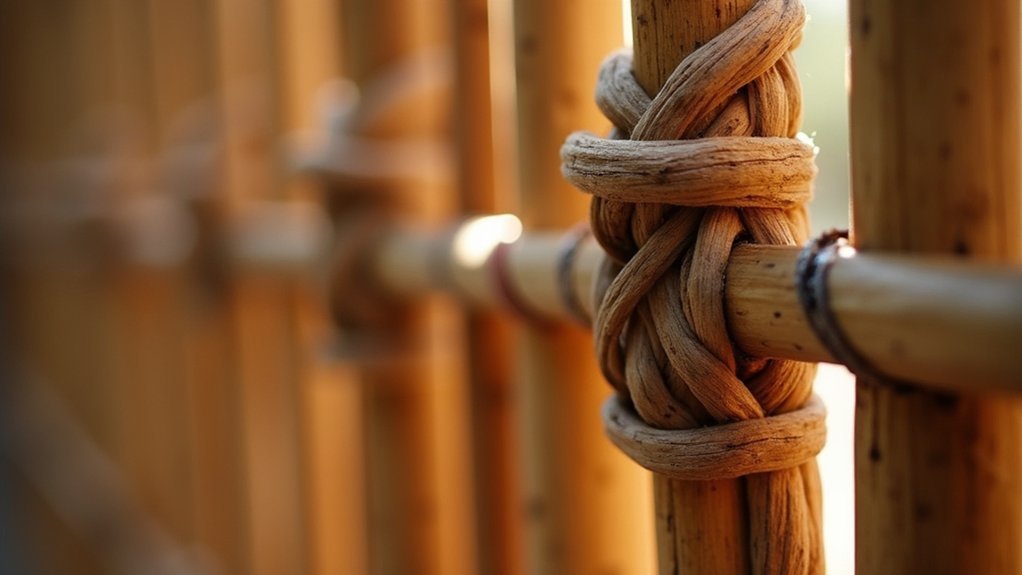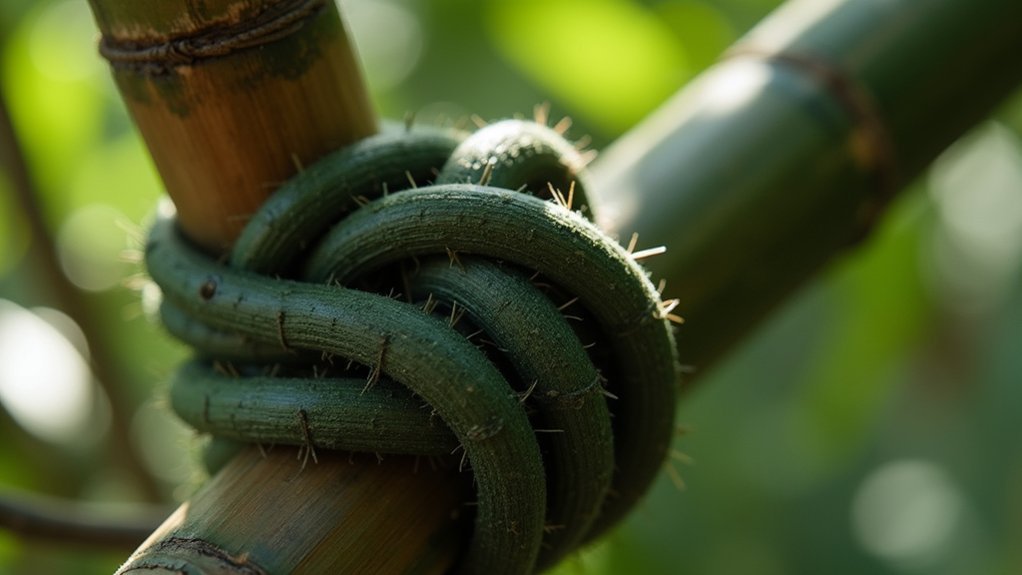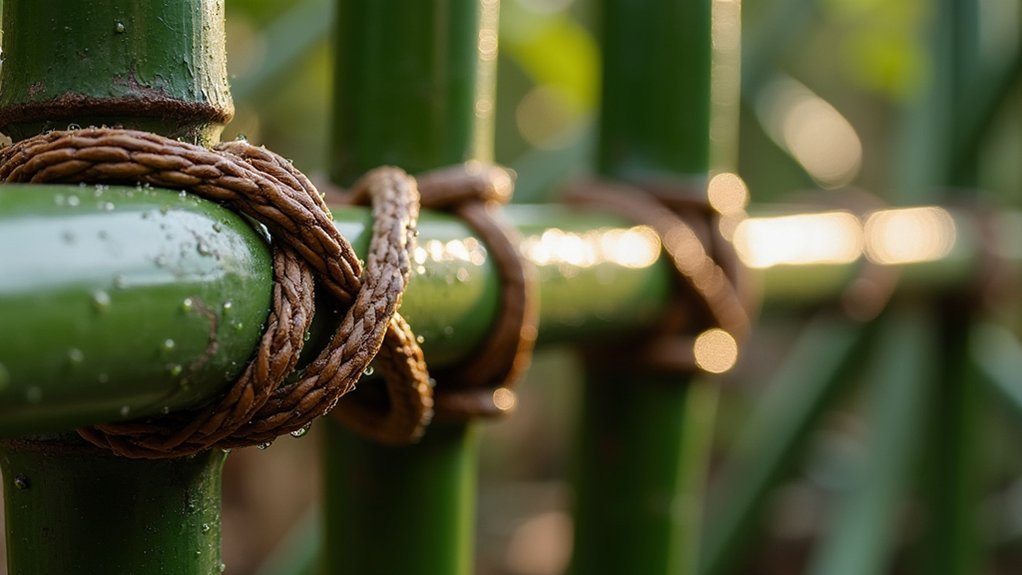Mastering traditional bamboo fence knots offers you both structural and cultural benefits. These ancient techniques create weather-tight joints that distribute stress evenly while connecting you to centuries of Japanese heritage. You’ll create stronger fences by positioning supports at bamboo nodes and using proper materials like hemp twine. Beyond practical advantages, you’re preserving art forms dating back to the Nara period. The wisdom behind these knots reveals itself through each carefully executed binding.
The Structural Advantages of Traditional Knot Techniques

When properly executed, traditional bamboo knot techniques provide far more than aesthetic appeal—they’re essential for structural integrity. Knots like the Ibo create weather-tight joints that distribute stress evenly across your fence, preventing structural failure over time.
You’ll maximize strength by positioning supports just before or above bamboo nodes—the natural reinforcement points. This strategic placement, combined with secure lashings, prevents weakening of poles and helps your fence withstand environmental stresses.
Diagonal corner supports greatly enhance stability at right angles, while meticulous braiding prevents shifting or collapse during high winds. Using materials like hemp twine or waxed lashing cord further reinforces the structure against weather elements.
Unlike modern fasteners, traditional knots work with bamboo’s natural properties, creating a fence that’s not just beautiful but also remarkably durable and structurally sound. For enhanced joint stability, consider using the angled tenon technique which utilizes pegs through drilled holes for superior crossbar support.
Cultural Heritage in Every Bamboo Binding
When you study traditional bamboo fence knots, you’re connecting with centuries of Japanese cultural heritage that flows through each carefully tied binding.
These distinctive knots don’t just secure bamboo poles; they tell stories of cultural movements from the Heian period through significant developments during the Momoyama era when tea culture flourished. The knots became popular artistic elements in ukiyo-e prints during the Edo period, showing their aesthetic and cultural significance beyond mere functionality.
You’ll find that mastering these knots helps preserve ancient techniques that bridge generations, reflecting Japan’s profound relationship with nature and seasonal change.
Artistry Through Generations
Through centuries of meticulous refinement, bamboo fence construction has transcended mere functionality to become a living museum of Japanese cultural heritage.
You’re participating in a tradition that originated in the Nara period (710-794), where temple gardens first incorporated these structures as artistic expressions.
Today’s craftspeople preserve over 20 distinct styles, including Edo-period Otsu fences that remain relevant in modern landscapes.
- Intergenerational knowledge transfer guarantees authentic techniques survive
- Each knot ties you to Buddhist principles of purity and resilience
- UNESCO-worthy methods reflect spiritual practices embedded in daily life
- Regional variations tell cultural narratives specific to their origins
- Annual reweaving at temples represents symbolic renewal and continuity
The popularity of these fences has expanded internationally due to their beauty and sustainability, making bamboo fence craftsmanship accessible to garden enthusiasts worldwide.
Binding Stories Together
In the bamboo knots that secure each fence panel, you’ll find more than mere physical bindings—you’re witnessing cultural narratives woven into functional art. Each Otoko-musu knot connects you to the Edo period artisans who perfected these techniques for both utility and beauty.
When you practice traditional bamboo binding, you’re not just creating a fence—you’re participating in storytelling that spans generations. The ibo-musubi technique proved to be both more economical and effective for securing the bamboo elements of yotsume-gaki.
The contrast of dark hemp-palm rope against golden bamboo tells of Japan’s aesthetic sensitivity to seasonal changes. In tea gardens, these knots create spaces that embody tranquility and meditation.
Knots Preserve Traditions
The humble bamboo knot serves as a silent guardian of Japanese cultural heritage, preserving centuries of traditional knowledge in each carefully executed binding. When you master these techniques, you’re not just learning a craft—you’re becoming part of an unbroken tradition dating back to the Heian period, connecting you to generations of artisans who shaped Japan’s aesthetic identity.
- Each knot style reflects specific cultural and historical significance, from tea ceremony gardens to Zen-influenced designs.
- Seasonal rebuilding of fences for New Year celebrations embodies Japanese values of renewal.
- Traditional hemp and palm rope tying methods represent an artistic dimension now rarely seen.
- Your craftsmanship preserves techniques that bridge ancient picture scrolls with contemporary landscapes.
- Learning these bindings helps maintain Japan’s architectural heritage in an increasingly modernized world.
The intricate weaving and braiding techniques used in bamboo fence construction are considered a form of artistic expression that demonstrates both technical skill and aesthetic sensibility.
Essential Tools and Materials for Authentic Fence Tying
For bamboo preparation, you’ll require sharp knives for trimming, drills for creating dowel holes, and sanding materials to smooth cut edges.
Split-closing tools with levers help tighten joints effectively. Don’t forget clamps to maintain tight fits during lashing.
Proper leverage tools ensure bamboo joints remain tight while sturdy clamps secure your work during the critical lashing phase.
When joining bamboo pieces, prepare for various lashing techniques including square, round, and diagonal knots. Apply hemp twine or waxed lashing cord for creating tight, secure joints that will withstand weather elements.
Examine poles carefully for diameter consistency and node integrity, removing material at contact points to guarantee tight, long-lasting connections.
Step-by-Step Guide to Mastering the Otoko Musubi Knot

Mastering the traditional Otoko Musubi knot requires patience and precise technique, but you’ll find the results well worth the effort. This “male knot” creates a square structure that’s both functional and aesthetically pleasing for bamboo fence construction.
Begin by soaking your palm fiber twine to increase pliability. Position yourself on the visible side of the fence and crisscross the twine around both poles tightly.
- Loop one end over and under the other strand to form an initial crossing
- Bring the free end up through the loop from behind to create the square structure
- Pull tight while maintaining the square shape
- Add a simple overhand knot a few inches away to secure
- Trim ends evenly for a clean, professional appearance
For authentic Japanese-inspired garden designs, consider growing multiple bamboo species like David from Country Whatnot Gardens who cultivates 25 varieties near Rochester, Indiana.
Extending Your Skills: Beyond Fencing Applications
Once you’ve become proficient with the Otoko Musubi knot, your bamboo expertise can flourish far beyond simple fencing projects.
Apply your skills to construction projects like bridges and towers where traditional knots guarantee structural integrity. Create durable furniture using square and diagonal lashing techniques.
Your bamboo craftsmanship can extend to decorative items such as wall art and headboards, or functional pieces like garden trellises and irrigation systems. Consider implementing drilled lashing joints for increased stability in your more complex structural designs.
Consider building outdoor structures like tiki bars or wedding arches for events.
Explore traditional Japanese styles featuring the Ibo Knot or innovate by combining modern materials—paracord and metal reinforcements—with traditional techniques for greater durability.
You’ll not only create beautiful, functional items but also contribute to sustainability through eco-friendly building practices that reduce environmental impact and repurpose bamboo waste.
Weatherproofing and Maintaining Your Knotted Bamboo Structures

Even the most artfully tied bamboo fences and structures require proper weatherproofing and regular maintenance to withstand the elements. By applying natural preservatives like hemp or tung oil, you’ll protect your bamboo from moisture and pests while preserving its natural beauty.
Remember that bamboo in ground contact typically rots within 2-3 years, so use hardwood posts as a foundation.
- Secure joints with hemp twine or waxed lashing cord for weather-tight connections
- Implement a 40-degree minimum roof pitch for proper water runoff
- Apply borax-based solutions through vertical soak diffusion before construction
- Inspect regularly for decay, especially at joints and ground contact points
- Replace outer layers of flattened bamboo (pelupuh) every 5-8 years as needed
For larger structures, consider upgrading to a terracotta tile roof system which can last up to 100 years with minimal maintenance compared to traditional bamboo roofing options.
Frequently Asked Questions
How Long Does It Take to Become Proficient in Bamboo Knotting?
You’ll need several months to a few years to become proficient in bamboo knotting. Your progress depends on practice frequency, quality of instruction, and whether you’re specializing in specific techniques.
Can Bamboo Knots Be Used With Other Materials Besides Bamboo?
Yes, you can adapt bamboo knots for hardwood, metal, and synthetic materials. Traditional lashing techniques work well with various materials, and you’ll find they’re often enhanced with metal fasteners or hardwood pegs for strength.
What Alternatives Exist for Those With Hand Mobility Limitations?
If you have hand mobility limitations, you’ll find several options: use knot-tying aids, ergonomic tools, mechanical tensioners, pre-manufactured fasteners, adhesives, or simpler knot variants requiring fewer movements. Assistive technologies can also help tremendously.
Are Bamboo Fence Techniques Different Across Asian Cultures?
Yes, you’ll notice distinct differences in Asian bamboo fence techniques. Japanese styles use ibo knots and wabi-sabi aesthetics, while Chinese methods favor thicker bamboo and symmetrical patterns. Korean approaches often incorporate stone bases for stability.
How Do Bamboo Knots Compare to Modern Fastening Systems?
Traditional bamboo knots offer aesthetic appeal and biodegradability but require skill and maintenance. You’ll find modern fastening systems provide superior strength, durability, and easier installation, though they lack the rustic charm and eco-friendliness of traditional methods.
In Summary
Mastering traditional bamboo fence knots isn’t just a practical skill—it’s your connection to centuries of craftsmanship. You’ll create stronger structures that withstand the elements while honoring cultural techniques that might otherwise be lost. As you’ve learned with the Otoko Musubi and other bindings, these methods extend far beyond fencing. With proper maintenance, your knotted creations will stand as a tribute to both tradition and your personal craftsmanship.





Leave a Reply